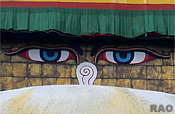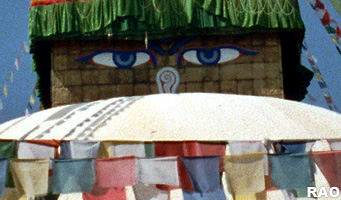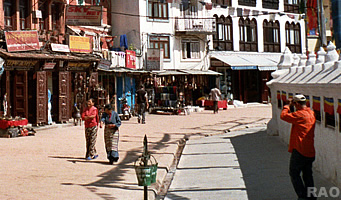 |
Nepal Religion |
 |
Nepal Information |
|
|
 |
|
Buddhist
site
|

|
 |
Boudhanatha
Stupa is one of the most revered Buddhist sites of this Himalayan Kingdom.
Just about half an hours bus ride from Ratnapark takes you to the coolest
religious shrine of this holy nation, the birthplace of Lord Buddha. This
stupa has been included in the world heritage lists of UNESCO.
There
are different stories about the creation of this holy place. According
to one story, a lady asked the king to give her some land so that she could
establish a divine Stupa. |
|
 |
Asthi
Dhatu, the remains of Kashyapa Buddha was put on the foundation and
a grand Chaitya was made. Her sons became the greatest religious teachers
of Buddhism and spread Buddhism over Tibet. It took two thousand five hundred
and fifty-five days to complete the Stupa. This religious shrine was established
during the sixth century.
 |
here
are different stories about the creation of this holy place. According
to one story, a lady asked the king to give her some land so that she could
establish a divine Stupa. Asthi Dhatu, the remains of Kashyapa Buddha
was put on the foundation and a grand Chaitya was made. Her sons became
the greatest religious teachers of Buddhism and spread Buddhism over Tibet.
It
took two thousand five hundred and fifty-five days to complete the Stupa. |
|
This religious shrine was established during the sixth century.
The
bizarre object that the prince unknowingly cut was none other than the
benevolent king himself. The prince took a lot of pain when he knew that
he had killed his own father and started remembering goddess Bajrayogini to be liberated from the unforgivable sin. Following the suggestion of
the goddess, the king constructed the present-day Stupa.
The
king became the devotee of Lord Buddha and he also wrote Bhajana,
on the supremacy of Lord Buddha, which is chanted during religious ceremonies.
The prince started weeping and went to Gumbihara and started meditating,
the power of which created a divinely beautiful Chaitya. King Manadeva had a special relation with Khasa, Tibet and that is why it is also referred
to as Khasa Chaitya. According to a story popular in Tibet, a Lama named Khasa had been incarnated in the form of King Mahadeva and the stupa was named
after that Lama.
The Chaitya of Chahabil was made using the remaining
materials of Boudhanath Chaitya. A Lama named Khasa died on his
pilgrimage to this Himalayan Kingdom and the Bouddha Stupa was established
in his memory. According to a story, the country suffered from a great
drought at that time and collecting dewdrops on Khasto (shawl), the Chaitya
was made and that is why the shrine is still referred to as Khasa Chaitya.
Gopalraj Bansawali has credited Shivadeva on the making of the divinely
beautiful Chaitya.
 |
| here
is a general belief that you will be relieved of your sins, if you do pranama
around the Buddha stupa. Dandavat pranama relieves you of all the sins.
The following are the rules and regulations set down and which must be
followed:
Different
kings and the people have renovated the Chaitya at times. Nepali and Tibetan
Buddhists have contributed a lot in conserving this Chaitya. |
|
While many
of the religious shrines and houses could not escape the mega-destruction
of the earthquake of 1990 B.S, it stood the test of time.
This
Stupa is the biggest Bouddha Stupa of Nepal. Different aspects of Lord
Buddha can be seen meditating around the Chaitya.
In
the centre, resides the beautiful image of Lord Bairochana, deep
in meditation. Akshovya is taking care of the east. Lord Amitabha and Lord Amoghsiddi can be seen on the western and the northern
direction and Lord Ratnashambhava prefers to look southwards. In
the one hundred and eight seats around the Stupa, different aspects of
Buddha, Bodhisattva and goddesses are shown in deep meditation. All one
hundred and forty-seven seats at ground level has a mane- a religious wheel.
Different melas, the festive occasions take place on this divine Chaitya.
During Lhosar, colourful pieces of cloths called Lungter are suspended
all over the Stupa. On that day, the shrine looks like a bride in all its
beauty and dignity. People visit the houses of the elderly to receive blessings
from them during Lhosar. Another festive occasion is the barha baras mela.
This festive occasion is celebrated every twelve years. It is generally
believed that it took twelve years to construct this religious shrine and
to commemorate the establishment of the Chaitya a great mela takes place
every twelve years.
Devotees from Nepal, Tibet, Sri-Lanka, India, Japan,
Korea and Burma gather around the Stupa to celebrate the festive occasion.
During the full moon day of Magha, the statue of Shukhontama is taken around the Bouddha Stupa. During Janai Purnima, the Stupa
is decorated with lungters and worshipped. Hundreds of thousands of pilgrims
from the world over visit this shrine to acheive peace of mind. Jugabatti should
be lightened forever and in case it is discontinued, a lamp has to be brought
from Bajrayogini and lit again.
This
religious shrine was listed on the world heritage list in October 1979.
Though the place is of historical importance, the houses made without proper
planning and management have somewhat destroyed its beauty, serenity and
dignity. The time has come for the department of Archaeology, the metropolis
and the local ward to do all things possible to restore it to its former
splendour.
The
officials at the department of Archaeology agree on this point. Chiniya
Lama, the president of Bouddha Ghyang Guthi, a trust committed to run the
day to day activities of the Stupa says that all the expenses of the sacred
place so far have been managed by the local people and no effort has been
made to collect foreign aid at a time when an increasing trend towards
Buddhism has been observed.
According to Gyani Bajra Bajracharya, a Lama,
the government should have implemented strict rules while the locals were
constructing buildings around the religious shrine. He says that the sacred
idols would have been lost had there been no houses around the shrine.
The government, the metropolis and the local ward may work together to
introduce a nominal entrance fee to maintain peace around the shrine and
it will help the authorities in upgrading the services at the shrine. Tourists
come here to escape from the crowded city environment.
There
is a general belief that you will be relieved of your sins, if you do pranama
around the Buddha stupa.
 |
| Dandavat pranama relieves you of all the sins.
The following are the rules and regulations set down and which must be
followed:
According
to the Ancient Monument conservation Act of 1956 and Ancient Monument
Conservation Regulations of 1969 were brought into practice to protect
the ancient monuments and to maintain its originality. |
|
Here
are some of the points that should be taken care of before starting the
construction work around the conserved area to maintain its originality.
The height of the floor building should be between 7.5 feet and 8 feet.
Height of the storey is measured from the base of the first floor to the
top of the consecutive floor. The maximum height of the building should
not exceed thirty-five feet. The height of the building should be lower
than that of the ancient monument nearby.
top
| more
information |
 |
| 










